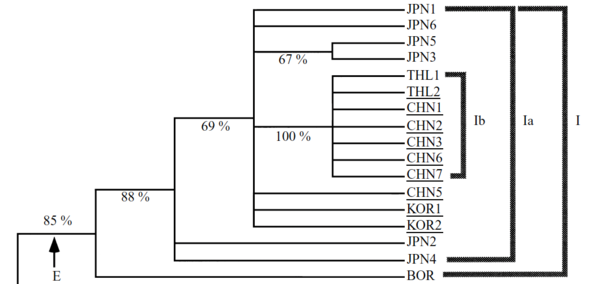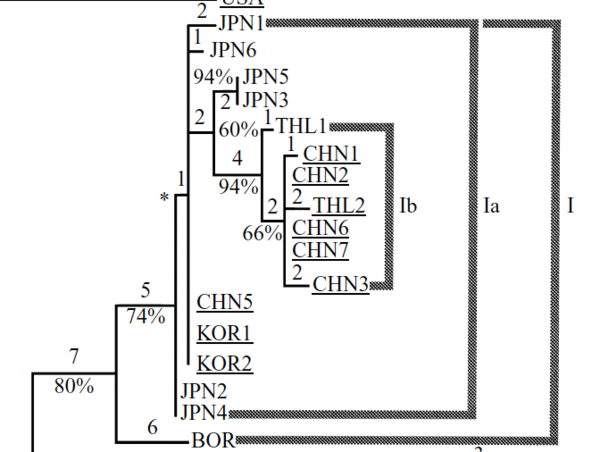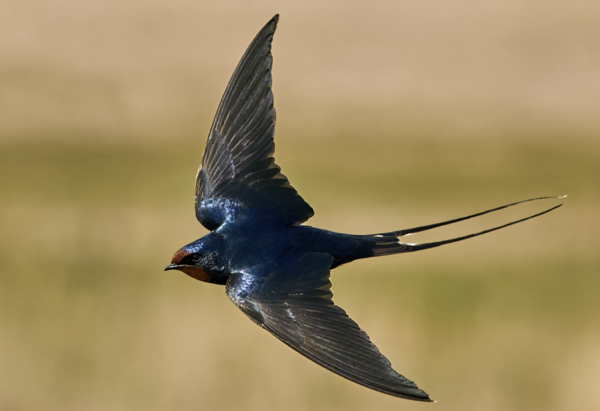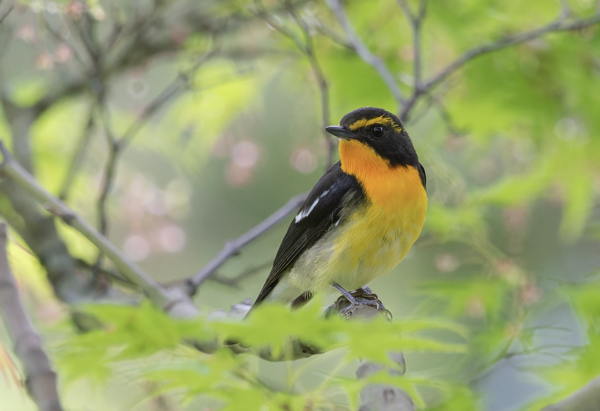Harvard University's DNA Analysis
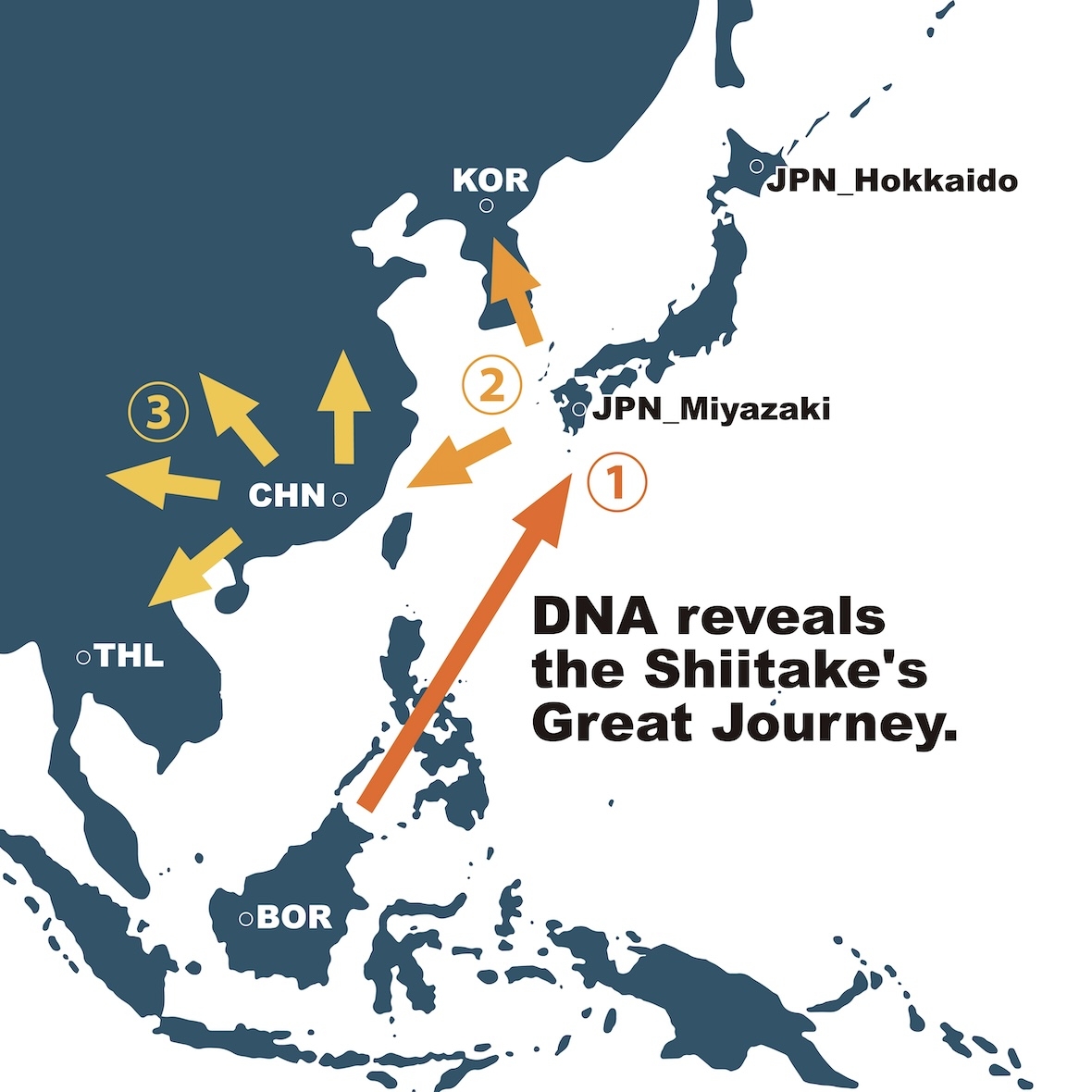
Tag: #ShiitakeDNA #GeneticResearch #DNASequencing #ShiitakeMushrooms #Genetics #ShiitakeBreeding #Genomics #StrainImprovement #ScientificResearch #MushroomResearch #Jomon #Satoyama
Table of Contents
Harvard University's DNA Analysis
According to the DNA analysis by Harvard University, the dispersal route of shiitake mushrooms (Lentinula edodes) has been revealed. It shows that shiitake spread sequentially from Borneo to Japan and then to mainland China. This study involved wild shiitake mushrooms collected from around the world.
Group I
BOR - Borneo
JPN1 - Ehime, JPN2 - Miyazaki, JPN3 - Okinawa, JPN4 - Hokkaido, JPN5 - Hokkaido, JPN6 - Okinawa
KOR1 - North Korea, KOR2 - North Korea
CHN1 - Zhejiang Province, CHN2 - Anhui Province, CHN3 - Sichuan Province, CHN4 - Hubei Province, CHN5 - Fujian Province, CHN6 - Sichuan Province, CHN7 - Jiangsu Province
THL1 - Thailand, THL2 - Thailand
The Harvard study used two methods of analysis. The difference between Fig. 2 and Fig. 3 lies mainly in the data encoding method. Fig. 2 treats gaps as missing data, while Fig. 3 treats gaps as independent characters. This difference affects the structure and number of phylogenetic trees generated and influences the interpretation of evolutionary relationships. Using both methods provides a more comprehensive understanding of the evolution and distribution of shiitake mushrooms.
What Fig. 2 Data Shows
The isolate from Borneo (BOR) is positioned at the base of Group I in Fig. 2, indicating that Borneo is the ancestor of all other isolates in Group I. The Japanese isolates JPN2 (Miyazaki) and JPN4 (Hokkaido) are positioned at the base of Group Ia, showing they are evolutionarily ancestral and closest to the common ancestor of other isolates.
The percentages shown in Fig. 2 represent bootstrap support values, which evaluate the reliability of clades in phylogenetic analysis. Higher values indicate higher reliability.
In addition to the E route, the paper also shows the A route, which involves dispersal to Papua New Guinea, Australia, and New Zealand.
What Fig. 3 Data Shows
Fig. 3 also shows that Borneo is the ancestor of all other isolates in Group I, with the Japanese isolates JPN2 and JPN4 positioned at the base of Group Ia, closest to the common ancestor of other isolates. The consistent positioning of Borneo and Japanese isolates in both analyses confirms the dispersal route from Borneo to Japan and then to mainland China.
The numbers shown in Fig. 3 indicate the number of evolutionary changes along each branch. For example, the branch for the Borneo isolate BOR is labeled "6," indicating it has diverged into six other isolates in Group Ia. Similarly, the Japanese isolates have diverged into five other isolates in Group Ia.
The 4,000 km Journey from Borneo to Japan
Several possibilities exist for how shiitake spores could travel the approximately 4,000 km from Borneo to Japan. Migratory birds are a likely dispersal method, as they travel long distances annually and could carry spores with them.
Dispersal by Migratory Birds
Several bird species are known to migrate between Borneo and Japan. These birds breed in Japan and migrate to Borneo and Southeast Asia for the winter, making them likely carriers of shiitake spores over long distances.
Wind Dispersal
Strong winds may carry shiitake spores over long distances. For example, research from Hirosaki University shows that typhoons carry bioaerosols (biological particles such as viruses, bacteria, moulds, mushroom spores, and pollen).
When Did Shiitake Arrive in Japan?
According to a study by the University of Texas, endemic Japanese shiitake species diverged from their ancestors (Borneo) around 3 million years ago (3 Mya). Subsequently, within 10,000 years, shiitake species also diverged from Japan to mainland China and the Korean Peninsula. Birds are likely the main agents of this dispersal. Modern humans (Homo sapiens) arrived in Japan much later, around 40,000 years ago. Thus, shiitake was likely already growing on fallen logs during the Jomon period.
The indigenous Aynu people of Japan, who richly inherited their genes from the Jomon period, have inherited a rich culture through oral tradition without writing. In Aynu culture, the name for shiitake varies depending on the tree it grows on. For example:
- Komni-karus: Shiitake growing on oak
- Pero-karus: Shiitake growing on chestnut
The Aynu people have different names for shiitake based on the type of wood they use, highlighting their gourmet culture. Additionally, shiitake mushrooms growing on sawtooth oak are regarded as the most delicious in our time.
Japanese research has shown that satoyama were already formed in the Jomon period, so people in the Jomon period would have often eaten shiitake mushrooms growing on fallen trees. This study utilized a combination of archaeological excavation, analysis of timber remains, and paleoenvironmental reconstruction to understand forest management practices in Jomon Hokkaido.
For example, chestnut trees (Castanea) were predominantly used in southeastern Hokkaido for thousands of years. These practices led to the formation of secondary forests, resembling Satoyama landscapes, characterized by the dominance of these specific tree species due to repeated cycles of cutting and regrowth.
Read more about the "The best land for Shiitake!" for additional insights.

